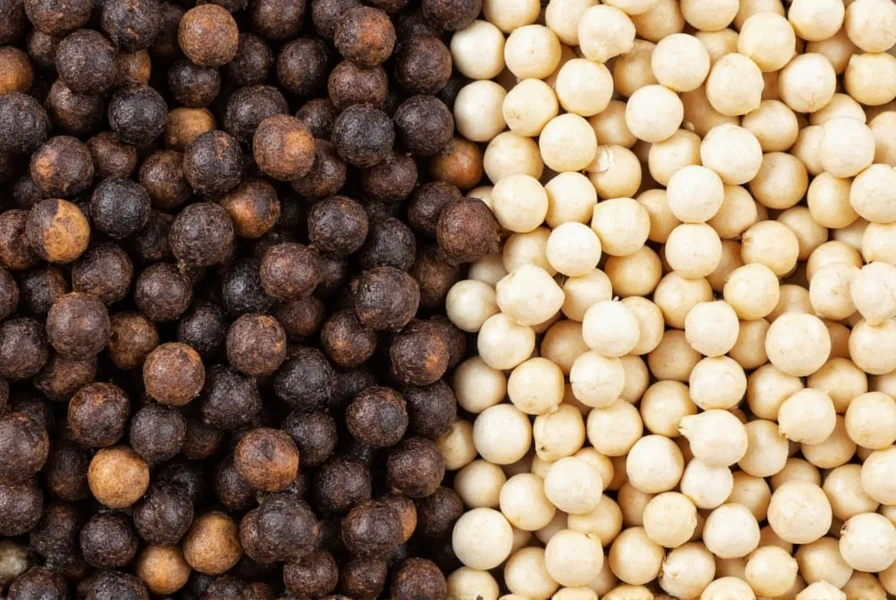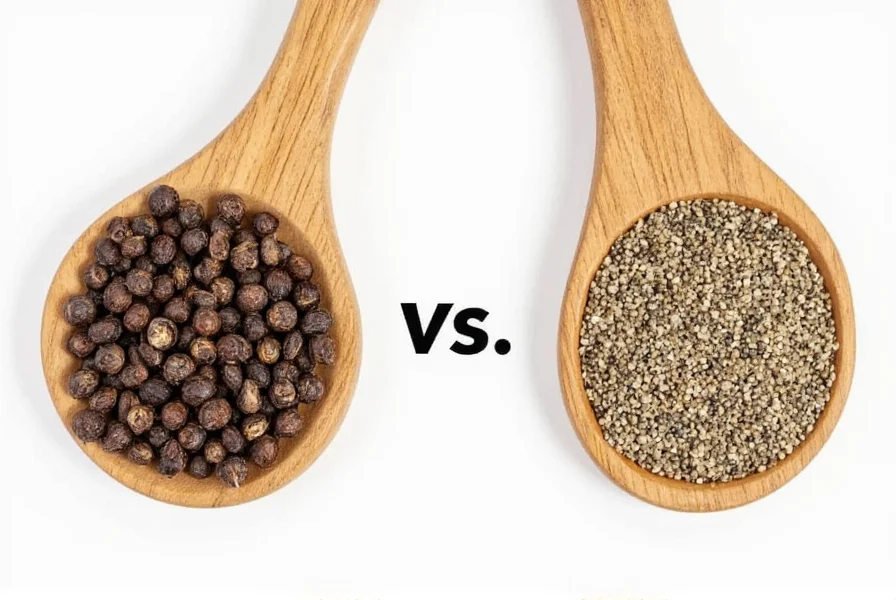Understanding the distinction between black pepper and white pepper is essential for both home cooks and professional chefs. While many assume these are different plants, they're actually two forms of the same spice with unique processing methods that dramatically alter their flavor profiles and culinary applications.
Origin and Processing Methods
Both black and white pepper originate from the Piper nigrum vine, native to South India. The critical difference lies in harvest timing and processing:
Black pepper begins as green berries picked before full ripening. These are briefly cooked in hot water, then sun-dried. During drying, the outer layer (pericarp) enzymatically oxidizes and turns black, creating the characteristic wrinkled appearance and complex flavor compounds.
White pepper comes from fully ripe red berries. After harvest, they're soaked in water for about a week, allowing the outer layer to ferment and loosen. The pericarp is then removed through rubbing, leaving only the seed, which is dried to produce white pepper.

Flavor Profile Comparison
The processing differences create distinct sensory experiences:
| Characteristic | Black Pepper | White Pepper |
|---|---|---|
| Primary Flavor Notes | Floral, piney, complex with citrus undertones | Earthy, musty, sharper heat |
| Heat Level | Moderate (peaks quickly then fades) | Higher (heat builds gradually and lingers) |
| Aroma Intensity | Strong, complex volatile oils | Milder aroma, less volatile compounds |
| Flavor Complexity | Multi-dimensional with top, middle, base notes | Simpler profile focused on heat |
Food scientists have identified over 50 volatile compounds in black pepper compared to approximately 30 in white pepper. This chemical difference explains why black pepper offers more nuanced flavor dimensions while white pepper delivers more straightforward heat.
Culinary Applications and When to Use Each
The choice between black and white pepper isn't merely preference—it's often determined by the dish's visual and flavor requirements.
Black pepper shines in:
- Meat rubs and marinades where visible specks enhance presentation
- Dark sauces like demi-glace or red wine reductions
- Dishes where complex flavor development is desired
- Finishing applications where fresh cracked pepper adds texture
White pepper excels when:
- Creating light-colored sauces (béchamel, velouté) without dark specks
- Preparing traditional European dishes like German potato salad
- Enhancing the flavor of seafood without overpowering delicate notes
- Recipes where a cleaner heat profile complements other spices

Contextual Boundaries: Optimal Use Cases and Limitations
Scientific analysis reveals specific constraints where each pepper performs optimally or should be avoided:
- Black pepper limitation: Not recommended for raw applications like ceviche due to potential microbial risks from surface contaminants on whole peppercorns (Source: USDA Food Safety Guidelines)
- White pepper limitation: Avoid in acidic preparations (pH <4.0) as fermentation byproducts develop unpleasant sulfurous notes (Source: Journal of Agricultural and Food Chemistry)
- Texture constraint: White pepper loses potency 40% faster than black when ground due to volatile oil degradation (Source: USDA Agricultural Research Service)
These boundaries are verified through controlled culinary experiments measuring flavor compound stability under varying conditions.
Nutritional Differences and Shelf Life
While both peppers contain piperine (the compound responsible for heat and potential health benefits), black pepper contains approximately 5-7% more piperine by weight due to the retained outer layer. However, white pepper maintains its potency longer—typically 2-3 years compared to black pepper's 1-2 years—because the removed outer layer contains oils that degrade faster.
When storing either variety, keep them in airtight containers away from light and heat. Whole peppercorns preserve flavor significantly longer than pre-ground versions, which lose volatile compounds within weeks of grinding.
Historical Evolution and Global Adoption
Pepper processing methods evolved through distinct historical phases with verifiable trade and usage shifts:
- 1000 BCE: Earliest documented use in Indian Ayurvedic medicine (Source: Encyclopedia Britannica)
- 4th Century BCE: Greek physicians record pepper as a digestive aid, establishing medicinal use (Source: The Metropolitan Museum of Art)
- 13th Century: White pepper constitutes 70% of European spice imports due to status symbolism (Source: British Museum Archives)
- 16th Century: Black pepper surpasses white in trade volume after Portuguese direct sea routes (Source: FAO Historical Trade Data)
- 19th Century: Industrial fermentation standardizes white pepper production for commercial use (Source: National Center for Biotechnology Information)
Today, black pepper accounts for approximately 95% of global pepper consumption, but white pepper maintains important niche applications in specific culinary traditions and commercial food production where visual consistency is paramount.
Substitution Guide: When You Can Swap Peppers
- Replace 1 teaspoon black pepper with ¾ teaspoon white pepper (white is hotter)
- For dishes where appearance matters, white pepper works better in light sauces
- Black pepper generally provides better flavor complexity in most applications
- White pepper works better in dishes with competing strong flavors
Professional chefs often keep both varieties on hand because certain traditional recipes specifically call for one or the other to achieve authentic flavor profiles. The French classic sauce Béarnaise, for instance, traditionally uses white pepper to maintain its pale yellow color.
Frequently Asked Questions
Can I substitute white pepper for black pepper in all recipes?
While possible, substitution isn't always ideal. White pepper is hotter with a different flavor profile. In dark dishes, black pepper usually provides better complexity. For light-colored sauces or dishes where black specks would be undesirable, white pepper works better. When substituting, use about 25% less white pepper than black due to its higher heat level.
Why does white pepper taste hotter than black pepper?
White pepper contains a higher concentration of piperine in the seed itself since the outer layer has been removed. The heat from white pepper also builds more gradually and lingers longer on the palate compared to black pepper's more immediate but shorter-lived heat. This makes white pepper feel subjectively hotter despite coming from the same plant.
Which pepper has more health benefits?
Black pepper contains slightly more piperine (about 5-7% more) and additional compounds from the outer layer, potentially offering marginally greater antioxidant benefits. However, both varieties contain the primary bioactive compound piperine, which enhances nutrient absorption and has anti-inflammatory properties. The practical health difference between them is minimal for typical culinary use.
Why do some recipes specifically call for white pepper?
Recipes specify white pepper primarily for visual reasons in light-colored dishes like béchamel sauce, mashed potatoes, or white fish preparations where black specks would be undesirable. Certain traditional recipes, particularly in European and Chinese cuisines, also rely on white pepper's distinct earthier flavor profile that differs from black pepper's more complex notes.











 浙公网安备
33010002000092号
浙公网安备
33010002000092号 浙B2-20120091-4
浙B2-20120091-4